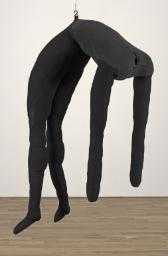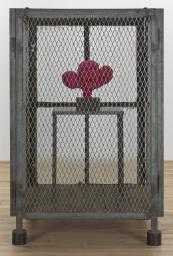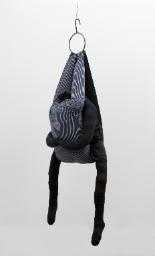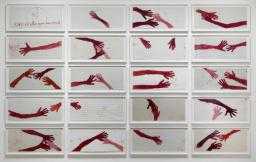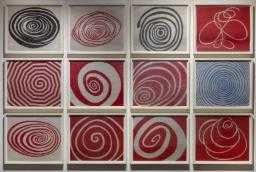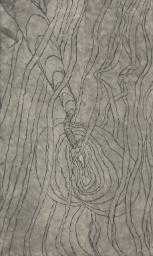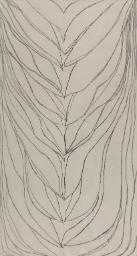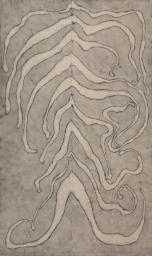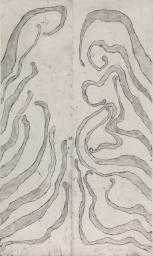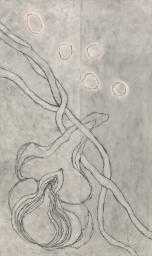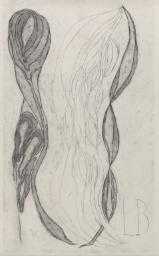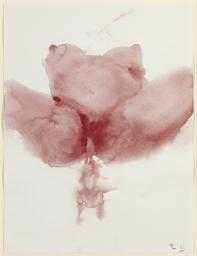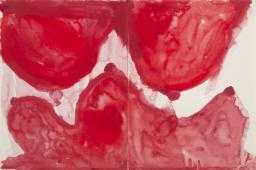
Not on display
- Artist
- Louise Bourgeois 1911–2010
- Medium
- Woven fabric, mounted on a stretcher
- Dimensions
- Support: 1105 × 1189 mm
- Collection
- ARTIST ROOMS
Tate and National Galleries of Scotland. Lent by Artist Rooms Foundation 2013
On long term loan - Reference
- AL00341
Summary
I Am Afraid is a fabric work by the French-born American artist Louise Bourgeois featuring lines of text woven into canvas. Short statements and individual words in upper case are woven in grey thread into the grey-beige fabric and are grouped into four stanzas. Both the first and the third stanza contain five lines of text; the second stanza contains three lines; and the fourth stanza contains two lines. The text reads:
I AM AFRAID OF SILENCE
I AM AFRAID OF THE DARK
I AM AFRAID TO FALL DOWN
I AM AFRAID OF INSOMNIA
I AM AFRAID OF EMPTINESS
IS SOMETHING MISSING?
YES, SOMETHING IS MISSING AND ALWAYS WILL BE MISSING
THE EXPERIENCE OF EMPTINESS
TO MISS
WHAT ARE YOU MISSING?
NOTHING
I AM IMPERFECT BUT I AM LACKING NOTHING
MAYBE SOMETHING IS MISSING BUT I DO NOT KNOW AND THEREFORE DO NOT SUFFER
EMPTY STOMACH EMPTY HOUSE EMPTY BOTTLE
THE FALLING INTO A VACUUM SIGNALS THE ABANDONMENT OF THE MOTHER
The material is mounted on a stretcher. The artist’s initials (‘LB’) are woven at the bottom right corner of the work.
Bourgeois made this work in 2005. She sourced the text from one of the many journals that she kept throughout her life. In these journals Bourgeois would keep notes relating to her work, her life and her mental state, and she would also write poems. The text featured in I Am Afraid has been taken from the artist’s archive of her poetic writing.
In this work the artist displays her various fears, which relate to both the physical world and abstract concepts. Thus her fears of hunger and abandonment sit alongside those of the dark and of emptiness. Bourgeois has examined these concepts throughout her work, particularly in her series of ‘Cells’, such as Cell XIV (Portrait) 2000 (Tate AL00230) and Cell (Eyes and Mirrors) 1989–93 (Tate T06899). The fears explored in her work often relate to emotionally traumatic events in the artist’s life and especially in her childhood. In I Am Afraid, Bourgeois traces a direct correlation between her self-confessed fears of the dark, silence and emptiness and a sense that something is missing. On the subject of Bourgeois’s use of painful experiences and personal fears in her work, curator Brooke Hodge has written:
Bourgeois has often remarked that, in order to exorcise the painful memories of her past, it is necessary for her to reconstruct them in order to destroy them. The restorative power of the needle and the act of sewing have enabled her to confront her demons through the creation of work that incorporates handsewn fabric shapes and figures, clothing and embroidery … giving her work another layer of personal meaning.
(Quoted in Morris 2007, p.266.)
Hodge therefore argues that in making her fears manifest in her stitched fabric works such as I Am Afraid, the artist is taking part in a process whereby she can deal with, and even ‘destroy’, her emotional pain and past traumas.
In I Am Afraid the artist also makes direct reference to the vacuum left by the ‘abandonment of the mother’. The loss of her mother, who died following a long illness when the artist was aged twenty-two, is another theme that recurs frequently in Bourgeois’s work. Writing about her childhood, much of which she spent helping her mother repair tapestries, Bourgeois said, in a statement first published in 1992:
My mother would sit out in the sun and repair a tapestry or a petit point. She really loved it. This sense of reparation is very deep within me. I break everything I touch because I am violent. I destroy my friendships, my love, my children. People would not generally suspect it, but the cruelty is there in the work … I break things because I am afraid.
(Quoted in Morris 2007, p.242.)
Like Hodge, Bourgeois makes the connection between the opposing acts of reparation and destruction and ties both to her childhood and her mother. I Am Afraid draws together these opposing themes in its visual evocation of the tapestries that they worked on, while explicitly documenting the fears that drive her figurative destructive tendencies.
Further reading
Mignon Nixon, Fantastic Reality: Louise Bourgeois and a Story of Modern Art, London and Cambridge, Massachusetts 2005.
Frances Morris (ed.), Louise Bourgeois, exhibition catalogue, Tate Modern, London 2007.
Lucy Askew and Anthony d’Offay, Louise Bourgeois: A Woman Without Secrets, exhibition catalogue, National Galleries of Scotland, Edinburgh 2013, p.88, reproduced p.67.
Allan Madden
The University of Edinburgh
January 2016
The University of Edinburgh is a research partner of ARTIST ROOMS.
Does this text contain inaccurate information or language that you feel we should improve or change? We would like to hear from you.
You might like
-
Louise Bourgeois Single II
1996 -
Louise Bourgeois Cell XIV (Portrait)
2000 -
Louise Bourgeois Couple I
1996 -
Louise Bourgeois 10 am is When You Come to Me
2006 -
Louise Bourgeois Spirals
2005 -
Louise Bourgeois Femme
2007 -
Louise Bourgeois The Nest
2009 -
Louise Bourgeois The Smell of Eucalyptus (#2)
2006 -
Louise Bourgeois Are You In Orbit? (#1)
2007 -
Louise Bourgeois Are You In Orbit? (#2)
2007 -
Louise Bourgeois Love and Kisses
2007 -
Louise Bourgeois The Unfolding
2007 -
Louise Bourgeois The Birth
2007 -
Louise Bourgeois The Family
2008 -
Louise Bourgeois The Friendly Landscape
2008

